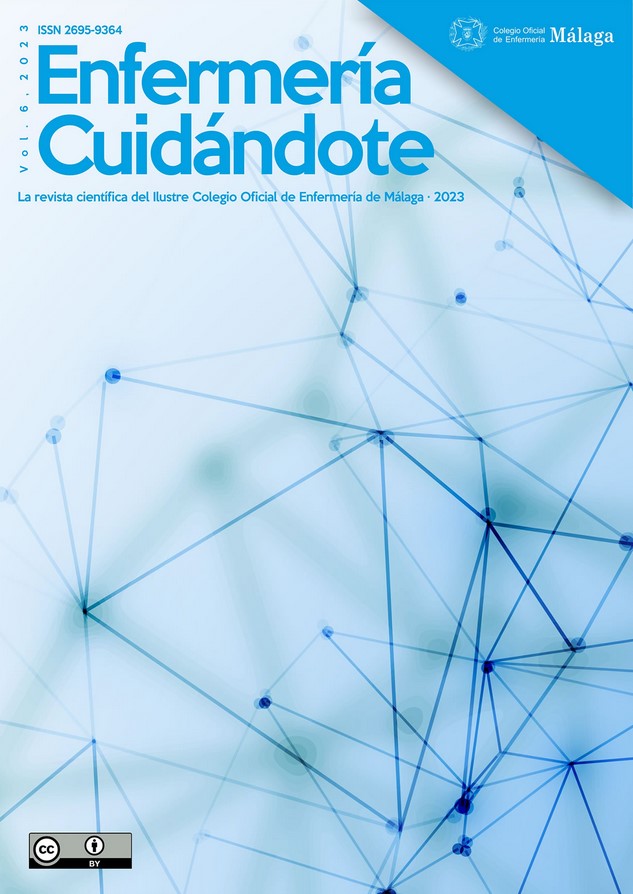Effect of a Occupational Health Nursing intervention to reduce sedentarism in hospital health professionals. Research Protocol
DOI:
https://doi.org/10.51326/ec.6.7715389Keywords:
Health Workers, Hospital, Occupational Nurse, Physical Activity, SedentaryAbstract
Introduction: Lack of physical activity is a major problem for physical, mental and occupational health. From occupational nursing we must ensure to promote and to protect the worker health to obtain optimal levels of well-being.
Objective: To assess whether there is an improvement in the level of physical activity of HRUM workers through interventions by occupational nursing.
Method: This study is a randomized clinical trial consisting of an intervention and control group. The population will be the professionals of the Hospital and the sample will be randomized with a systematic rule, following the order of arrival at the occupational medical examinations. Sociodemographic data will be asked and the level of physical activity will be assessed using the International Physical Activity Questionnaire IPAQ, the aptitude to exercise with the PAR-Q Questionnaire and the degree of motivation to change. The nursing intervention will be a prescription of physical exercise through motivacional advice.
Downloads
References
GBD 2015 Risk Factors Collaborators. Global, regional, and national comparative risk assessment of 79 behavioural, environmental and occupational, and metabolic risks or clusters of risks, 1990–2015: a systematic analysis for the Global Burden of Disease Study 2015. Lancet. 2016;388(10053):1659-724. https://doi.org/10.1016/s0140-6736(16)31679-8
Sánchez-Cruz J., García L, Mayoral J,. V Encuesta Andaluza de Salud Pública (Adultos) 2015 – 2016. Granada: Consejería de Salud, Escuela Andaluza de Salud Pública: 2017. Disponible en: https://juntadeandalucia.es/export/drupaljda/La%20Salud%20en%20Andaluc%C3%ADa-%20Adultos.pdf [Consultado 19/02/2022]
Organización Mundial de la Salud (WHO). Ginebra. Organización Mundial de la Salud; 2023. Actividad física; 26 de Noviembre de 2020. Disponible en: https://www.who.int/es/news-room/fact-sheets/detail/physical-activity [Consultado 22/02/2022]
Bull FC, Armstrong T, Dixon T, Ham S, Neiman A, Pratt M. Physical inactivity. En: Ezzati M, Lopez AD, Rodgers A, Murray CJL (Eds.). Comparative quantification of health risks: Global and regional burden of disease due to selected major risk factors. Ginebra: World Health Organization; 2004. p.729-881.
Remor E, Pérez-Llantada MC (2007). La relación entre niveles de la actividad física y la experiencia de estrés y de síntomas de malestar físico. Rev Interam Psicol. 2007;41(3):313-22. Disponible en: https://www.redalyc.org/articulo.oa?id=28441306 [Consultado 27-02-2022]
Cancer.net. Alexandria (Virginia): American Society of Clinical Oncology. 2023. Actividad física y riesgo de cáncer; Enero de 2016. Disponible en: cancer.net/es/desplazarse-por-atencion-del-cancer/prevención-y-vida-saludable/actividad-fisica-y-riesgo-de-cáncer [Consultado 10-02-2022]
Fox KR. At least five a week. Evidence of the impact of physical activity and its relationship to health. A report from the Chief Medical Officer. London: HMSO; 2004. 90 p.
Glenister D. Exercise and mental health: A review. J R Soc Promot Health. 1996;116(1):7-13. https://doi.org/10.1177/146642409611600102
Shirom A, Toker S, Berliner S, Shapira I, Melamed S. The effects of physical fitness and feeling vigorous on self-rated health. Health Psychol. 2008;27(5):567-75. https://doi.org/10.1037/0278-6133.27.5.567
Steinberg H, Nicholls BR, Sykes EA, LeBoutillier N, Ramlakhan N, Moss, TP et al. Weekly exercise consistently reinstates positive mood. Eur Psychol. 1998;3(4):271-80. https://doi.org/10.1027/1016-9040.3.4.271
Fox KR. The effects of exercise on self-perceptions and self-esteem. En: Biddle SJH, Fox KR, Boutcher SH. (Eds.). Physical activity and psychological well-being. New York: Routledge Press; 2001. p. 88-117.
Craft LL. Exercise and clinical depression: Examining two psychological mechanisms. Psychol Sport Exerc. 2005;6(2):151-71. https://doi.org/10.1016/j.psychsport.2003.11.003
Thøgersen-Ntoumani C, Fox KR, Ntoumanis N. Relationships between exercise and three components of mental well-being in corporate employees. Psychol Sport Exerc. 2005;6(6):609-27. https://doi.org/10.1016/j.psychsport.2004.12.004
Musich S, Hook D, Baaner S, Edington DW. The association of two productivity measures with health risks and medical conditions in an Australian employee population. Am J Health Promot. 2006;20(5):353-63. https://doi.org/10.4278/0890-1171-20.5.353
Hayden JA, Ellis J, Ogilvie R, Malmivaara A, van Tulder MW. Exercise therapy for chronic low back pain. Cochrane Database Syst Rev. 2021;9:CD009790. https://doi.org/10.1002/14651858.CD009790.pub2
Díez Fernández JM. Estudio de los factores clínico-epidemiológicos de las lumbalgias en trabajadores y su relación con la satisfacción laboral. Rev Asoc Esp Espec Med Trab. 2018; 27: 232-243. Disponible en: https://scielo.isciii.es/scielo.php?script=sci_arttext&pid=S1132-62552018000400006
Gates DM, Succop P, Brehm BJ, Gillespie GL, Sommers BD. Obesity and presenteeism: The impact of body mass index on workplace productivity. J Occup Environ Med. 2008;50(1):39-45. https://doi.org/10.1097/jom.0b013e31815d8db2
Dishman RK, Oldenburg B, O’Neal H, Shephard RJ. Worksite physical activity interventions. Am J Prev Med. 1998;15(4):344-61. https://doi.org/10.1016/s0749-3797(98)00077-4
Rostami K, Ghodsbin F. Effect of Yoga on the Quality of Life of Nurses Working in Intensive Care Units. Randomized Controlled Clinical Trial. Invest Educ Enferm. 2019; 37(3):e06. Disponible en: http://www.scielo.org.co/pdf/iee/v37n3/2216-0280-iee-37-03-e06.pdf [Consultado 27-02-2022]
Túnez Rodríguez L, Martínez de la Peña RA, López Túnez Marina, Granado Alba A, Sánchez Martín J, López Valverde MA et al. Guía para Disminuir el Sedentarismo. Sevilla: Servicio Andaluz de Salud; 2017. Disponible en: https://www.sspa.juntadeandalucia.es/servicioandaluzdesalud/sites/default/files/sincfiles/wsas-media-pdf_publicacion/2021/guia_disminuir_sedenterismo.pdf [Consultado 27-02-2022]
García Gómez M, Esteban Buedo V, Gallo Fernández M, Artieda Pellejero L, Guzmán Fernández A. Vigilancia de la Salud para la prevención de riesgos laborales. Guía básica y general de orientación. Madrid: Ministerio de Sanidad, Consumo y Bienestar Social; 2017. Disponible en: https://www.sanidad.gob.es/ciudadanos/saludAmbLaboral/docs/guiavigisalud.pdf [Consultado 14-02-2022]
González Sánchez J. Aplicación del proceso de atención de enfermería a la salud laboral. Med Segur Trab. 2011;57(222):15-22. Disponible en: https://scielo.isciii.es/pdf/mesetra/v57n222/especial2.pdf [Consultado 20-02-2022]
North American Nursing Diagnosis Association (NANDA International). Diagnósticos enfermeros: definiciones y clasificación 2018-2020. 11ª ed. Barcelona: Elsevier; 2019.
Moorhead S, Swanson E, Johnson M, Maas M. Clasificación de Resultados de Enfermería (NOC): Medición de Resultados en Salud. 6ª ed. Barcelona: Elsevier; 2019.
Butcher M, Bulechek G, Dochterman JM, Wagner CM. Clasificación de Intervenciones de Enfermería (NIC). 7ª ed. Barcelona: Elsevier; 2019.
Consejería de Salud y Familias. Servicio Andaluz de Salud. Plantilla de centros sanitarios cuarto trimestre 2021. Sevilla: Servicio Andaluz de Salud; [Fecha desconocida]. Disponible en: https://web.sas.junta-andalucia.es/servicioandaluzdesalud/profesionales/guia-laboral/plantilla-de-centros-sanitarios/plantilla-de-centros-sanitarios-cuarto-trimestre-2021 [Consultado 21-01-22]
Canadian Society for Exercise Physiology. PAR-Q & YOU. Ontario: Canadian Society for Exercise Physiology; 2002.
USA Spanish version translated 3/2003 - SHORT LAST 7 DAYS SELF-ADMINISTERED version of the IPAQ – Revisado en Agosto de 2002. Disponible en: https://docs.google.com/viewer?a=v&pid=sites&srcid=ZGVmYXVsdGRvbWFpbnx0aGVpcGFxfGd4OjdkYzIwZjc4YWI2YjQ4MWE
Craig CL, Marshall A , Sjöström M, Bauman AE, Booth ML, Ainsworth BE et al. International Physical Activity Questionnaire: 12 country reliability and validity. Med Sci Sports Exerc. 2003;35(8):1381-95. https://doi.org/10.1249/01.mss.0000078924.61453.fb
Cabrera A, Gustavo A, El modelo transteórico del comportamiento en salud. Rev Fac Nac Salud Publ. 2000;18(2):129-38. Disponible en: https://www.redalyc.org/articulo.oa?id=12018210




















